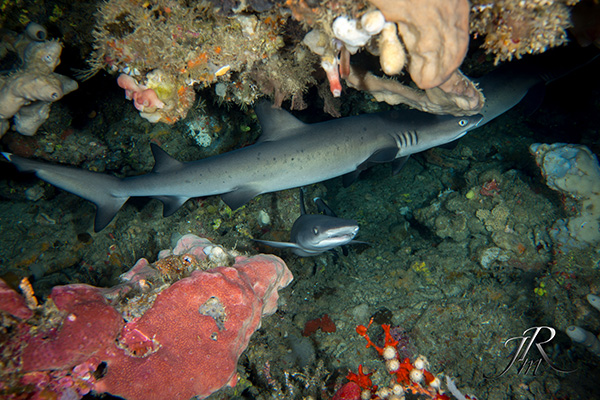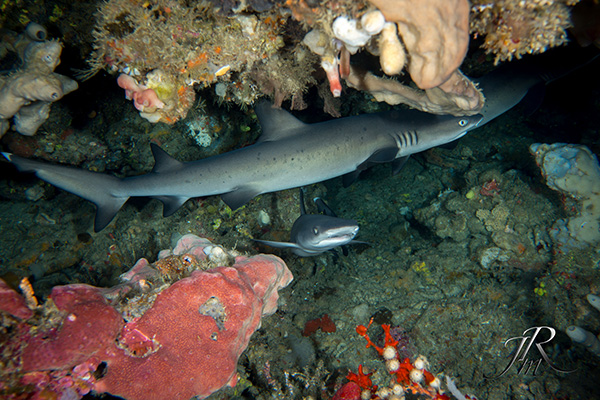Whitetip Reef Shark Facts
|December 21, 2023

The deep waters found throughout Bunaken Marine Park are home to some of the most diverse coral reef ecosystems in the world.
Although there are thousands of different species found within these waters, there are fewer large or pelagic species than in other, similar locations. We rarely find manta rays or whale sharks (although both do occasionally get sighted), however we do have far more macro critters than most other parts of Indonesia.
Despite not having an abundance of larger fish, we still have a few larger residents. Eagle rays, Napoleon wrasse, giant trevally and a couple of different tuna species to name a few. Probably the most exciting and regular large encounter we have is with reef sharks. Bunaken Marine Park is home to several species of shark, with the most common sighting being Whitetip Reef Sharks.Â
What is a Whitetip Reef Shark?

Scientifically known as the Triaenodon obesus, the âWhitetip Reef Sharkâ is a species of requiem shark, and along with the Blacktip Reef Shark and the Grey Reef Shark, it is one of the most frequently encountered sharks in the Indo-Pacific.
Although they are related to other reef sharks, they are unique among the requiem sharks in that they can pump water over their gills to breathe. All other requiem sharks rely on a process known as âram ventilationâ, where the shark must swim constantly in order to breathe. Because white-tip reef sharks are able to pump water through their gills, they are able to lay on the substrate to rest.
How to Identify Whitetip Reef Sharks.Â
When compared to most other well known sharks, the whitetip reef shark is fairly small, but with a maximum length of two metres, they are one of the largest regular sightings around Bunaken Marine Park. This puts them at roughly the same length as blacktip reef sharks, however the whitetips are much slimmer.
The head is short and they have a flattened snout with skin flaps protruding from their nostrils. Their most identifying feature is their first dorsal fin, which is sits much further back than most other sharks – closer to the pelvic fin than the pectoral fins. As their name implies, the tips of their first dorsal fin (and sometimes other fins) are tipped bright white.
What do Whitetip Reef Sharks Eat?Â
Whitetip reef sharks have a fairly different feeding technique to most other sharks.
They are relativity slow swimmers, which means they find it much more difficult to stalk down prey in open waters like a blacktip or grey reef would do. Instead, they hunt in the cover of night, where they use their slender bodies to wriggle through the crevices in the reef, looking for animals seeking shelter and sleeping fish.
They have been spotted hunting in small groups, with the sharks working together to target the same prey, often with multiple sharks blocking the exits while one shark drives the prey into another waiting sharks mouth. Another way they are unique among requiem sharks is that they do not become overly excited when feeding in groups, and therefore are very unlikely to become part of a feeding frenzy.
Their diet consists of a variety of small reef fish, such as; eels, squirrelfish, goatfish, parrotfish, and triggerfish, however they will also eat crustaceans such as octopus, cuttlefish, crabs and lobsters.Â
Whitetip Reef Shark Reproduction.Â
Like many other shark species, whitetip reef sharks are viviparous, which means the eggs are kept in the placenta of the female shark until birth.
The male will pursue the female shark for an extended period, after which the male will grasp onto the female by the pectoral fins to move the two into a proper reproductive position. After mating, the female shark will go through a gestation period that lasts between ten to thirteen months, before giving birth to a litter that consists of one-six pups. The newborn whitetip reef sharks will measure between 50-60 centimetres, and will receive no parental care from either parents.
It is thought whitetips become sexually active at around five years of age, at which point the males will be roughly one metre in length, and the females will be slightly larger.Â
Where Can I Spot Whitetip Reef Sharks?Â
As the name implies, these sharks can be found living around the coral reefs. Their preferred depth range is between eight and forty metres, although they have been recorded living much deeper.
Throughout Bunaken Marine Park, whitetip reef sharks are far shyer than they are in other parts of the world. Most of your encounters with free swimming whitetip reef sharks will be with the shark swimming several metres below you, so remember to look down every now and then!
As previously mentioned, whitetip reef sharks are unique among the requiem sharks in that they can breathe while stationary. This gives us a great advantage in finding them, as during the day they are usually hiding in a small cave or under a table coral. They will usually gather in groups of three or four inside these hiding spots, where they will simply rest on the bottom or swim in circles until night fall. They will usually return to the same hiding spot after every nights hunt, so once we know where some live, there is a strong possibility that they will be there next time.
We almost always know where at least one shark cave is, so if you would like to see some, please let either your dive guide, or a member of the dive centre management know, so they can plan accordingly. Just remember that this is nature, so we can never guarantee any sightings.
The post Whitetip Reef Shark Facts appeared first on Siladen Resort & Spa Indonesia.